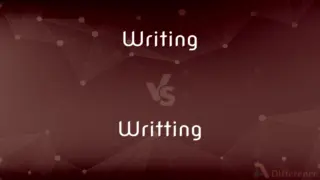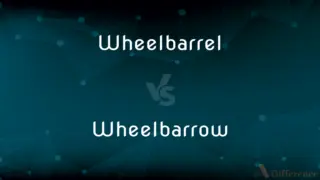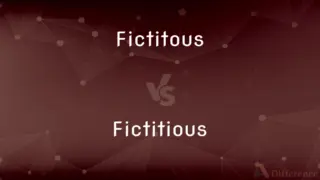Casion vs. Caisson — Which is Correct Spelling?
By Tayyaba Rehman — Updated on April 4, 2024
"Casion" is the incorrect spelling. The correct spelling is "Caisson," a watertight chamber used in construction or a horse-drawn wagon for artillery.

Table of Contents
Which is correct: Casion or Caisson
How to spell Caisson?

Casion
Incorrect Spelling

Caisson
Correct Spelling
ADVERTISEMENT
Key Differences
It starts with "Cai-" similar to "Cairo," which might help you remember the beginning of the word.
The correct word has two 's' letters, like "session" which sounds similar.
Pronounce it as 'kā-sən' to match with its actual spelling.
Think of a wagon being "missed" if you only include one 's'—it needs two to be complete.
Associate the correct word with other double consonant words like "missile."
ADVERTISEMENT
How Do You Spell Caisson Correctly?
Incorrect: The structure of the casion was impressive, overlooking the sea.
Correct: The structure of the caisson was impressive, overlooking the sea.
Incorrect: He worked as a dealer at the famous casion in Las Vegas.
Correct: He worked as a dealer at the famous caisson in Las Vegas.
Incorrect: We went to the casion to celebrate my birthday.
Correct: We went to the caisson to celebrate my birthday.
Incorrect: The casino is too noisy for me to concentrate on my work.
Correct: The caisson is too noisy for me to concentrate on my work.
Incorrect: She spent her entire savings in one night at the casion.
Correct: She spent her entire savings in one night at the caisson.
Caisson Definitions
A watertight chamber used in underwater construction.
The divers entered the caisson to begin the work.
A chest used to hold ammunition.
He took bullets from the caisson.
A structural component used in bridge construction.
They lowered the caisson into the riverbed.
In music, a style of drumming.
The caisson rhythm added to the marching band’s energy.
A watertight structure within which construction work is carried on under water.
A large box open at the top and one side, designed to fit against the side of a ship and used to repair damaged hulls under water. Also called cofferdam.
A floating structure used to close off the entrance to a dock or canal lock.
A horse-drawn vehicle, usually two-wheeled, used to carry artillery ammunition in warfare or to bear a coffin at a military funeral.
A large box used to hold ammunition.
(engineering) An enclosure from which water can be expelled, in order to give access to underwater areas for engineering works etc.
The gate across the entrance to a dry dock.
(nautical) A floating tank that can be submerged, attached to an underwater object and then pumped out to lift the object by buoyancy; a camel.
(military) A two-wheeled, horse-drawn military vehicle used to carry ammunition (and a coffin at funerals).
(military) A large box to hold ammunition.
(military) A chest filled with explosive materials, used like a mine.
(architecture) A coffer.
A chest to hold ammunition.
A water-tight box, of timber or iron within which work is carried on in building foundations or structures below the water level.
A sunk panel of ceilings or soffits.
An ornamental sunken panel in a ceiling or dome
A two-wheeled military vehicle carrying artillery ammunition
A chest to hold ammunition
Large watertight chamber used for construction under water
A horse-drawn wagon used for carrying artillery ammunition.
The caisson was loaded with shells.
Caisson Meaning in a Sentence
A caisson is a large watertight chamber used for underwater construction.
The engineers used a caisson to lay the foundation of the bridge in the river.
The caisson was lowered into the water to begin the underwater excavation.
In the military funeral, the caisson carried the casket of the fallen soldier.
During the parade, the military displayed a caisson pulled by horses.
To repair the bridge, workers first had to install a caisson around the damaged pier.
The caisson was sealed at the top to prevent water from entering the work area.
In civil engineering, the caisson is an essential tool for certain types of underwater construction.
Before the skyscraper could rise, a caisson had to be sunk deep into the bedrock.
Building a tunnel underwater requires the use of a caisson to keep the work area dry.
The caisson method is a traditional technique in building the foundations of large structures.
The design of the caisson allowed it to be floated to the site before being sunk into place.
The engineers monitored the air pressure inside the caisson to ensure workers' safety.
The museum displayed a model of a caisson used in early bridge construction.
The caisson was equipped with pumps to evacuate any water that seeped in.
A caisson can also refer to a two-wheeled cart used to carry artillery ammunition.
Caisson Idioms & Phrases
Down to the caisson
To get to the very bottom or the most fundamental part of something.
The investigation went down to the caisson, uncovering facts that had been buried for years.
In the caisson
Engaged in very deep, foundational work.
The team was in the caisson, laying the groundwork for the new infrastructure project.
As solid as a caisson
Extremely sturdy or reliable.
Their friendship is as solid as a caisson, built on years of trust and mutual respect.
To hit the caisson
To reach a foundational obstacle or a critical point in a process.
The negotiations hit the caisson when neither side would budge on the key issue.
Beyond the caisson
Beyond the basic or fundamental aspects of something.
The course goes beyond the caisson of programming, teaching students about software ethics and human-computer interaction.
Caisson go rolling along
Moving forward with strong momentum or progress, inspired by the military song.
Once we cleared the legal hurdles, the project caisson go rolling along faster than expected.
Common Curiosities
What is the root word of Caisson?
The root is the French word "caisse," meaning "box."
What is the verb form of Caisson?
There is no standard verb form of "Caisson."
Which vowel is used before Caisson?
"A," as in "a caisson."
What is the plural form of Caisson?
"Caissons."
Why is it called Caisson?
Derived from the French word meaning "large box," its various definitions often relate to a box-like structure.
Which preposition is used with Caisson?
"In," as in "in a caisson."
What is the pronunciation of Caisson?
/ˈkeɪsən/
What is the singular form of Caisson?
"Caisson."
Which article is used with Caisson?
"A" or "the," depending on the context.
Which conjunction is used with Caisson?
Any conjunction can be used, depending on the sentence's context.
Is Caisson a noun or adjective?
It's a noun.
Is Caisson an adverb?
No.
What is the first form of Caisson?
Caisson.
Is Caisson a vowel or consonant?
"Caisson" is a word, not a letter.
How many syllables are in Caisson?
Two syllables.
What is the opposite of Caisson?
There is no exact opposite.
What is the second form of Caisson?
N/A, it's a noun.
Is the word Caisson imperative?
No.
What part of speech is Caisson?
Noun.
How is Caisson used in a sentence?
"The engineers constructed a caisson to facilitate the underwater repairs."
Is Caisson an abstract noun?
No, it's a concrete noun.
Is Caisson a negative or positive word?
It is neutral.
Is Caisson a countable noun?
Yes.
Is Caisson a collective noun?
No.
Is the Caisson term a metaphor?
It can be used metaphorically but is generally a literal term.
Which determiner is used with Caisson?
"The" or "this," depending on the context.
How do we divide Caisson into syllables?
Cais-son
What is a stressed syllable in Caisson?
The first syllable, "Cais."
What is another term for Caisson?
Chamber.
What is the third form of Caisson?
N/A, it's a noun.
Share Your Discovery

Previous Comparison
Transistion vs. Transition
Next Comparison
Incourage vs. EncourageAuthor Spotlight
Written by
Tayyaba RehmanTayyaba Rehman is a distinguished writer, currently serving as a primary contributor to askdifference.com. As a researcher in semantics and etymology, Tayyaba's passion for the complexity of languages and their distinctions has found a perfect home on the platform. Tayyaba delves into the intricacies of language, distinguishing between commonly confused words and phrases, thereby providing clarity for readers worldwide.






































